7th international conference and Exhibition on Pharmacognosy, Phytochemistry and Natural Products
Osaka, Japan
Seungye Lee
University of Santo Tomas, Philippines
Title: Inhibitory Effect of Wrightia Antidysenterica Leaf Extracts Against In Vitro Culture Systems of Streptococcus Spp.
Biography
Biography: Seungye Lee
Abstract
In the Philippines, Streptococcus infections remain a public concern and accounts for one of the leading causes of morbidity and mortality. Recent studies have shown efforts wherein herbal plants were tested and proven to have antibiotic effects. With this, the researchers sought to determine the inhibitory effect of Wrightia antidysenterica, a plant local to the Philippines, against Streptococcus spp. Streptococcus pyogenes, S. agalactiae, S. pneumoniae, and vancomycin-resistant S. constellatum were used in the study. The leaves were extracted using hexane, dichloromethane, and n-Butanol solvents and tested against Streptococcus spp. using the Kirby-Bauer disc diffusion method. The n-Butanol leaf extract, which exhibited the optimal inhibitory effect against the Streptococcus spp., was then assayed for Minimum Inhibitory Concentration (MIC) and Minimum Bactericidal Concentration (MBC). In addition, S. pyogenes and S. agalactiae species exhibited the most susceptible to the n-Butanol leaf extract, having an MBC of 125 mg/mL. Statistical analysis showed that the zones of inhibition exhibited by the n-Butanol leaf extract on all Streptococcus spp. have no significant difference (p > 0.05). Games-Howell post hoc analysis was done to determine the significant difference between Streptococcus spp. and the standard antibiotic vancomycin. Results revealed that S. pyogenes (p=.030; CI 2.03 – 23.99), S. agalactiae (p=.022; CI 5.41 – 26.58), and S. pneumoniae (p=.026; CI 3.50 – 23.17) have significant difference with vancomycin. The inhibitory effect of the W. antidysenterica n-Butanol leaf extract has a significant difference with the standard antibiotic vancomycin, indicating that herbal preparations could be considered as an alternative option for the treatment of Streptococcal infections.

